余志远《英国国家概况》笔记和课后习题详解-爱尔兰共和国、美国(第11~22章)【圣才出品】
- 格式:pdf
- 大小:1.21 MB
- 文档页数:123
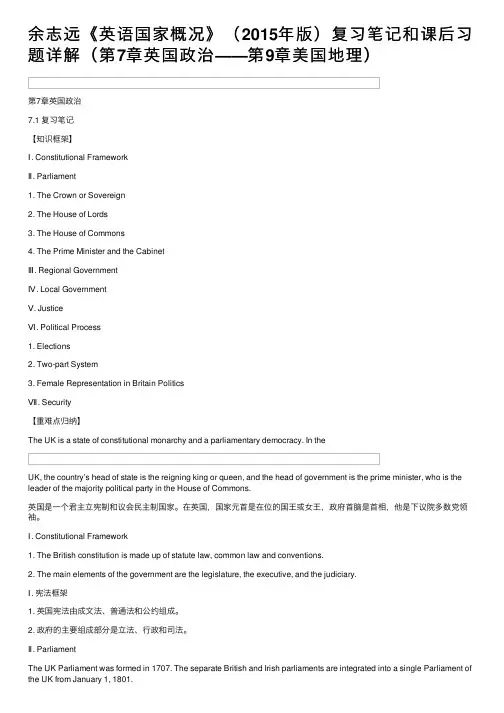
余志远《英语国家概况》(2015年版)复习笔记和课后习题详解(第7章英国政治——第9章美国地理)第7章英国政治7.1 复习笔记【知识框架】Ⅰ. Constitutional FrameworkⅡ. Parliament1. The Crown or Sovereign2. The House of Lords3. The House of Commons4. The Prime Minister and the CabinetⅢ. Regional GovernmentⅣ. Local GovernmentⅤ. JusticeⅥ. Political Process1. Elections2. Two-part System3. Female Representation in Britain PoliticsⅦ. Security【重难点归纳】The UK is a state of constitutional monarchy and a parliamentary democracy. In theUK, the country’s head of state is the reigning king or queen, and the head of government is the prime minister, who is the leader of the majority political party in the House of Commons.英国是⼀个君主⽴宪制和议会民主制国家。
在英国,国家元⾸是在位的国王或⼥王,政府⾸脑是⾸相,他是下议院多数党领袖。
Ⅰ. Constitutional Framework1. The British constitution is made up of statute law, common law and conventions.2. The main elements of the government are the legislature, the executive, and the judiciary.Ⅰ. 宪法框架1. 英国宪法由成⽂法、普通法和公约组成。
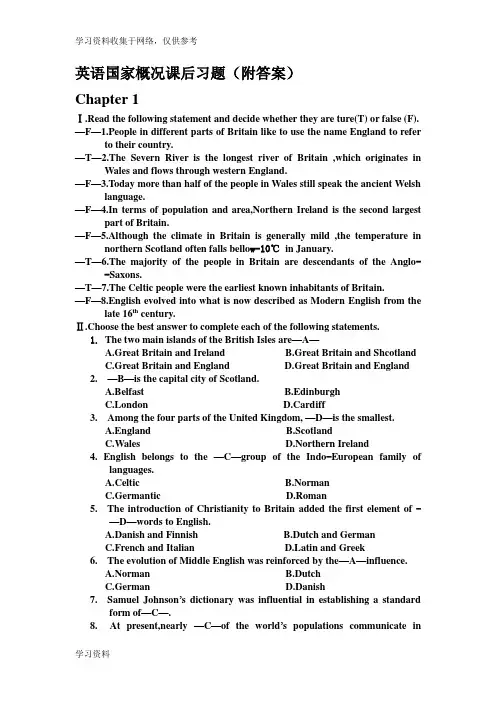
英语国家概况课后习题(附答案)Chapter 1Ⅰ.Read the following statement and decide whether they are ture(T) or false (F). —F—1.People in different parts of Britain like to use the name England to refer to their country.—T—2.The Severn River is the longest river of Britain ,which originates in Wales and flows through western England.—F—3.Today more than half of the people in Wales still speak the ancient Welsh language.—F—4.In terms of population and area,Northern Ireland is the second largest part of Britain.—F—5.Although the climate in Britain is generally mild ,the temperature in northern Scotland often falls bello w-10℃in January.—T—6.The majority of the people in Britain are descendants of the Anglo--Saxons.—T—7.The Celtic people were the earliest known inhabitants of Britain. —F—8.English evolved into what is now described as Modern English from the late 16th century.Ⅱ.Choose the best answer to complete each of the following statements.1.The two main islands of the British Isles are—A—A.Great Britain and IrelandB.Great Britain and ShcotlandC.Great Britain and EnglandD.Great Britain and England2. —B—is the capital city of Scotland.A.BelfastB.EdinburghC.LondonD.Cardiff3. Among the four parts of the United Kingdom, —D—is the smallest.A.EnglandB.ScotlandC.WalesD.Northern Ireland4. English belongs to the —C—group of the Indo-European family oflanguages.A.CelticB.NormanC.GermanticD.Roman5. The introduction of Christianity to Britain added the first element of -—D—words to English.A.Danish and FinnishB.Dutch and GermanC.French and Italiantin and Greek6. The evolution of Middle English was reinforced by the—A—influence.A.NormanB.DutchC.GermanD.Danish7. Samuel Johnson’s dictionary was influential in establishing a standardform of—C—.8. At present,nearly —C—of the world’s populations communicate inEnglish.A.halfB.a quarterC.one thirdD.one fifthⅢ.Give brief answers to the following questions.1.Why do tourist from all over the world like go to Scotland?2.How many periods can the development of the English language be dividedintoand what are they?3.Why did English become more important after the Black Death?Ⅳ.State your understanding of the following questions.1.Who are the British people?2.What is Standard English?Chapter 2Ⅰ.Read the following statements and decide whether they are true(T) or false(F). —T—1.Birtish history before 55 BC is basically undocumented.—T—2.The Anglo Saxon came to Britain in the 5th century.—F—3.The chief or king of the Anglo Saxon tribes exercised power at their own will.—T—4.The Viking began to attack the English coast in the 8th century. —T—5.Henry Ⅱbuilt up a large empire which included England and most of france.—F—6.The Magana Carta was designed to protect the rights of both the privileged class and townspeople.—F—7.The Hundred Years’War was a series of wars fought between the British and the Vikings for trade and territory.—T—8.In an effort to make a compromise between different religious factions,Queen Elizabeth Ⅰactually defended the fruit the Reformation. Ⅱ. Choose the best answer to complete each of the following statements.1. The—D—attack on Rome ended the Roman occupation in Britain in 410.A. NormanB. DanishC.CelticD.Germanic2. By the late 7th century, —D—became the dominant religion in England.A. Celtic ChristianityB. Anglo Saxons ChristianityC.Germanic ChristianityD. Roman Christianity3. The—C—marked the establishment of feudualism in England.A.Viking invasionsB. signing of the Magna CartaC.Norman ConquestD.adoption of common law4. The end of the Wars of the Roses led to the rule of—C—A.the House of ValoisB. the House of YorkC. the House of TudorD. the House of Lancaster5. The direct cause ofor the Reformation was King Henry Ⅷ’s effortto—A—.A.divorce his wifeB.break with RomeC.support the ProtestantD.declare his supreme power over the church6. The English Civil War broke out in1642 between —B—A.the Protestant and the PuritansB.the Royalist and the ParliamentarianC.the nobles and the peasantsD.the aristocrats and the Christians7. —A—was passed after the Glorious Revolution.A.The Bill of RightsB.The Act of SupremacyC.The Provisions of OxfordD.The Magna Carta8. The Industrail Revolution was accomplished in Britain by the middle ofthe —C—century.A.17thB.18thC.19thD.20thⅢ.Give brief answers to the following questions.1.What were Queen Victoria’s major achievements?2.What were the two camps in the World WarⅠ?3.Why did Britain cooperate closely with the Uinited States after World War Ⅱ?Ⅳ.State your understanding of the following questions.1.What were the results of the Industrail revolution in Britain?2.Explain the rise and fall of the British Empire.Chapter 3Ⅰ.Read the following statements and decide whether they are true(T) or false(F). —T—1.Conventions are regarded less important than the statutory law in the working of the England government.—F—2.The British monarchy has never been interrupted throughout the history.—F—3.In reality,the British King or Queen is the house of all government powers.—F—4.The British Parliament is the law making body of the Commonwealth of Nations.—F—5.The members of the House of Commons are appointed rather than elected.—T—6.The British Prime Minister is the leader of the minority party in Parliament.—F—7.Cabinet members are chosen by the Prime Minister from various political parties in Parliament.—T—8.The legal systems in England ,Wales,Scotland and Northern Ireland are much similar in terms of law,orgalizations and practice.Ⅱ. Choose the best answer to complete each of the following statements.1.The British government is characterized by a division of powers betweenthree of the following branchs EXCEPT the—C—.A.judiciaryB.legislatureC.monarchyD.executive2. The importance of the British monarchy can be seen in its effect on—D—.A.passing billsB.advising the gowernmentsC.political partiesD.public attitude3. As a revising chamber ,the House of Lords is expected to—B—the Houseof Commons.A.rivalplementC.criticizeD.inspect4. —A—is at the center of the British political system.A.The CabinetB.The House of LordsC.The House of CommonsD.The Privy Council5. The main duty of the British Privy Council is to —B—.A.make decisionsB.give adviceC.pass billsD.supervise the Cabinet6. Generally speaking,the British Parliament operates on a —B—system.A.single partyB.two partyC.three partyD.multi party7. The politices of the Conservative Party are characterized by pragmatismand—D—.ernment interventionB.nationalization of enterprisesC.social reformD.a belief in individualiam8. In Britain,the parliamentary general election is held every—C—years.A.threeB.fourC.fiveD.sixⅢ.Give brief answers to the following questions.1.What are the three functions of the House of Commons?2.What kind of public image does the Liberal Democrats have in Britain?3.Why are independent candidates unlikely towin in the general elections? Ⅳ.State your understanding of the following questions.1.What do British electoral campaigns usually involves during the processof a general election?2.What is the Commonwealth of Nations?Chapter 4Ⅰ.Read the following statement and decide whether they are ture(T) or false (F). —T—1.Britain was the first industrialized nation in the world.—T—2.The British economy experienced a relative decline during the postwar period.—F—3.Limited resources and high unemployment rate were persistent. —F—4.Thatcher’s revolution turned out to be agreat success in dealing with all the British economic and social problems.—T—5.The economic approach adopted by Tony Blair was different from that of the old Labor Party and the Conservetive Party.—T—6.Blair made the Bank of England independent in oder to separate politics from economic policy.—F—7.Britain is an important oil exporter since its oil industry has a long history.—T—8.Nuclear power is one of the major energy sources in Britain.Ⅱ.Choose the best answer to complete each of the following statements.1. The —A—in the early 1970s worsened an already stagnant economy in Britain.A.oil crisisB.high inflation ratesrge importsD.unemployment problem2. Of the following practices, —C—did not belong to Thatcher’s social welfare reform.A.reducing child benefitsB.shortening the period of unemployment benefitsC.reducing unemploymentD.lowering old age pension3. The Blair government was successful in the following aspect EXPECT—D—.A.limiting government spendingB.keeping inflation under controlC.reducing unemploymentD.reducing inequality4. Britain has devoted about—C—of its land area to agriculture.A.50%B.60%C.70%D.80%5. Britain’s important fishing areas include all the following EXCEPT—D—.A.the North SeaB.the English ChannelC.the area around the Irish coastD.the sea area between Britain and Ireland6. Coal mining industry in Britain provides—B—of the energy consumed inthe country.A.one thirdB.one fourthC.one fifthD.two thirds7. The car industry in Britain is mostly —A—.A.foreign ownedB.state ownedC.joint ownedD.privately owned8. Of the following sectors in Britain, —C—has experienced spectaculargrowth since the end of the World War Ⅱ.A.agricultureB.the energy industryC.the service sectorD.the manufacturing industryⅢ.Give brief answers to the following questions.1.What was the negative aspect of Thatcher’s reform in the early 1980s.2.What are the charactoristics of Britain’sagriculture?3.What happened to Britain’s beef industry in the mid 1990s?Ⅳ.State your understanding of the following questions.1.What were the major causes of Britain’s relative economic decline in thepostwar period?2.Why do developed nations like Britian encourage the development of the service industry?Chapter 5Ⅰ.Read the following statement and decide whether they are ture(T) or false (F). —F—1.The Britain government has been responsible for education since the early 1800s.—F—cation inBritain is compulsory for all children between the ages of 6 and 15.—F—3.The National Curriculum is compulsory in both the states system and the independent system.—T—4.When children finish their schooling at 16,they are required to take a national GCSE examination.—T—5.Graduates from state schools in Britain have a less favorable chance to enter famous universities than those from independent schools. —F—6.The Times is the world oldest Sunday newspapers.—F—7.The BBC World Service broadcast only in English throughout the world. —T—8. Some British holidays are celebrated to mark important events in the Christian calendar,and some others are related to local customs and traditions.Ⅱ.Choose the best answer to complete each of the following statements.1. In Britain,the division between grammer schools and vocational schools was ended by the introduction of comprehensive schools in the —D—.A.1930sB.1940sC.1950sD.1960s2. Over—C—of British children receive primary and secondary education through the independent system.A.5%B.6%C.7%D.Partially funded 8%3. Partially funded by central government grants,most of the British universities receive the remaining funds from all the following sources EXCEPT—B—.A.tuition feesB.loansC.donationsD.corporate contributions4. To be admitted to the Open University, one needs—B—.A.some educational qualificatonsB.no educational qualificationsC.the General Certificate of Education Advanced level.D. the General Certificate of Secondary Education5. Among Britain’s quality press,the following newspapers are regarded asthe “Big Three”EXCEPT—C—.A.The TimesB.The GuardianC.The ObserverD.The Daily Telegraph6. Life On Earth is a kind of —C—program produced by the BBC is popularworldwide.A.radioB.dramaC.documentaryD.soap opera7. —D—is Britain’s top pay television provider.A.BSBB.SkyTVC.BBCD.BSkyB8. The following Christmas traditions are particularly BritishEXCEPT—A—.A.Trooping the ColorB.the Queen’s Christmas messageC.Boxing DayD.the Christmas pantomimeⅢ.Give brief answers to the following questions.1.What used to be the major functions of grammer schools and vocational schools in Britain.2.What kind of subjects do British comprehensive schools provide?3.In what ways do British universities enjoy complete academic freedom?4.What role does the media play in Britain leisure culture?Ⅳ.State your understanding of the following questions.1.What are the general features of Britain’s independent schools?2.What are the “Quality Press”and the “tabloids”in Britain?Chapter 6Ⅰ.Read the following statement and decide whether they are ture(T) or false (F). —F—1.The Canterbury Tales is representative work of the old English period. —T—2.The Renaissance is characterized by admiration of the Greek and Latin classic works.—T—3.As a great English peot,Alexander Pope also translated Homer’s Iliad. —F—4.Jhonathan Swift is probably the foremost prose satirist in the English language,and Robinson Crusoe is his masterpiece.—F—5.William Wordsworth amd Sumuel Taylor Colerdge brought the Romantic Movement to its height.—F—6.Lord Byron distinguished himself by the musical quality of his short poems,such as “Ode to the West Winds”.—F—7.Jane Austen is a well known novelist of the stream of consciousness school.—T—8.Joseph Conrad is classified as a forerunner of Modernism,which prevailed before World War Ⅱ.Ⅱ.Choose the best answer to complete each of the following statements.1. The most significant achievement of the English Renaissance is—B—.A.poetryB.dramaC.novelD.pamphlet2. —C—is viewed as Romantic poetry’s “Declaration of independence”.A. “I Wonder Lonely as a Cloud”B.Don JuanC.The preface to Lyrical BalladsD.Prometheus Unbound3.Of Dicken’s novels, —B—is considered most autobiographical.A.A Tale of Two CitiesB.Davied CopperfiedC.Oliver TwistD.Great Expectations4. —D—is a representative of English Critical Realism in the turn of the 19thcentury.A.Robert Louis SetevensonB.John MiltonC.Joseph ConardD.Thomas Hardy5. Of the following books, —C—is NOT written by Thomas Hardy.A.Jude the ObscureB.Tess of the d’UrbervillesC.Adam BedeD.The Return of the Native6. —A—is not included in the modernist group.A.Oscar WildeB.Virginia WoolfC.William Bulter YeatsD.T.S.Eliot7. Of the following writers, —B— is NOT a Nobel Prize winner.A.Samuel BeckettB.James JoyceC.William GoldingD.V.S.Naipual8. Waiting for Godot is written by—A—.A.Samuel BeckettB.Geroge OrwellC. William GoldingwranceⅢ.Give brief answers to the following questions.1.What are the three catergries of Shakespeare’s plays and their representatives?2.What is Critical Realism?3.What are the two new literary trends prevailing at the end of 19th century?4.What is the stream of consciousness?Ⅳ.State your understanding of the following questions.1.What is Romanticism?2.What are the characteristics of English literauture in the 20th century?Chapter 7Ⅰ.Read the following statement and decide whether they are ture(T) or false (F). —F—1.The Republic of Ireland occupies the entire area of the island of Ireland. —F—2.The earliest inhabitants in Ireland were Celtic tribes from Europe. —F—3.In the 1800s, Ireland gained in prosperity because it became a part of Britain.—T—4.In the 1930s, Ireland was not indeed a republic, but belonged to the British Commonwealth of Nations.—F—5.Ireland’s economy wasn’t affected by World War Ⅱbecause it remained neutral during the war.—F—6.In 1949, Britain recognized the independence of the Irish Republic and returned the six northern counties.—F—7.English is the only official language in Ireland because the majority of people speak it as their mother tongue.—T—8.Catholicism in Ireland is more than a mere matter of private faith, but of public identity.Ⅱ.Choose the best answer to complete each of the following statements.1. --B-- established a unified Irish culture and language in the 6th century BC.A. Hunter-gatherers from BritainB. Celtic tribesC. British invadersD. The Vikings2. Divergent views about --C--resulted in the Irish Civil War.A. the Act of UnionB. the Unilateral Declaration of IndependenceC. the Anglo-Irish TreatyD. the Anglo-Irish Agreement3. --C---was the first Irish President to visit Queen Elizabeth Ⅱ.A. Eamon de ValeraB. John A. CostelloC. Mary RobinsonD. Albert Reynolds4. ---D--brought Anglo-Irish relations to a new height.A. The British recognition of the Irish RepublicB. The signing of the Downing Street DeclarationC. The signing of the Belfast AgreementD. The IRA’s formal declaration of the disarmament in 20055. In Ireland, the head of state is--B---A. the Prime MinisterB. the PresidentC. the British monarchD. the General Governor6. ---C---has been the dominant party in Ireland since 1930s and supportspeaceful reunification of the island of Ireland.A. Fine GaelB. The Labor PartyC. Fianna FailD. The Progressive Democrats7. Emigration in Ireland started since the --A--A. medieval periodB. 17th centuryC. Great Potato FamineD. early 18th century8. Ireland now has a --B-- economy.A. agriculture-basedB. knowledge-basedC. industry-basedD. foreign investment-basedⅢ.Give brief answers to the following questions.1. Why was Cork given the nickname “the Rebel County”?2. Who were the first groups of people that came to Ireland?3. Why did Ireland remain neutral in World War Ⅱ?Ⅳ.State your understanding of the following questions.1. What is the significance of the following documents: the Act of Union, the Anglo-Irish Treaty, the Anglo-Irish Agreement and the Belfast Agreement?2. What are the goals of the main political parties in Ireland?Chapter 8Ⅰ.Read the following statement and decide whether they are ture(T) or false (F). —F—1.The eastern highlands formed by the Appalachian Range hold one-third of the country’s continental territory.—T—2.The climate in the United States can be classified as temperate, with some mild subtropical and tropical zones.—T—3.A 50-centimeter rainfall line runs through the middle of the United States.—T—4.New York is composed of five boroughs, including Manhattan, Brooklyn, the Bronx, Staten Island and Queens.—F—5.San Francisco is the second largest city after New York and the world-famous Hollywood is located here.—T—6.During the 1830s and the 1840s, many Northern Europeans and Irish immigrants came to America.—T—7.Almost half of the immigrants coming to the United States in the 1980s were Asians.—T—8.Basic American cultural values are freedom, equality and desire to work hard for a higher standard of living.Ⅱ.Choose the best answer to complete each of the following statements.1. The U.S. lies in --B--North America, with Canada to the north, Mexico to the south, the Atlantic to its ----and the Pacific to its -----.A. northern, east, westB. central, east, westC. southern, west, eastD. western, west, east2. The continental United States has--C---states.A. 50B. 49C. 48D. 353. The state of --A--- is the largest in area of all the U.S. states.A. AlaskaB. HawaiiC. TexasD. Florida4. The longest river in the U.S. is ---B---A. the Missouri RiverB. the Mississippi RiverC. the Ohio RiverD. the Lake Itasca5. Some of the world-famous universities like Harvard, Yale and MIT arelocated in--C--.A. the SouthB. the WestC. New EnglandD. the Midwest6. San Francisco, Los Angeles and San Diego all belong to --D--A. MontanaB. UtahC. MaineD. California7. The Immigration Act of 1924 restricted further immigration into theUnited States, particularly from--A----.A. EuropeB. AsiaC. AfricaD. South America8. The characteristics of the dominant American culture are--D-A. English-speaking, Northern European, Roman Catholic andmiddle-classB. English-speaking, Western European, Roman Catholic and upper-classC. English-speaking, Northern European, Protestant and upper-classD. English-speaking, Western European, Protestant and middle-classⅢ.Give brief answers to the following questions.1. How is the American population distributed?2. Why was the Immigration Act of 1924 instituted?Ⅳ.State your understanding of the following questions.1. Why is the United States regarded as a “melting pot” and a “salad bowl”?2. What do you think is the best way to help assimilation in a multicultural society?Chapter 9Ⅰ.Read the following statement and decide whether they are ture(T) or false (F). —T—1.American was named after Amerigo Vespucci,who arrived on the new continent after Columbus.—F—2.The Second Continental Congress was held in Phiadelphia,and the Continental Army and Navy was established under the command of Thomas Jerfferson.—T—3.The Amemrican Civil War not only put an end to slavery,but also make American a single,indivisible nation.—F—4.Most American people approved of the Vietnam War.—T—5.In1990,American troops and the troops from allied nations took joint military action in order to drive Iraqi troops out of Kuwait.—F—6.According to the American government,Saddam Hussein and Osama bin Laden were responsible for the terrorist event on Septemble11,2001. —T—7.The Bush administration regarded Iraq a nation among the “axis of the evil”.—F—8.On March 20,2003,American and United Nations’troops, supposed by several other countries,began an invasion of Iraq.Ⅱ.Choose the best answer to complete each of the following statements.1. The first successful English conoly in North America was founded at—C—in——.A.Jamestown,LouisianaB.Boston, MassachusettsC.Jamestown,VirginiaD.Plymouth,Gergia2. The Seven Years’War occurred between—C—.A.the French and the American IndiansB.the French and the SpanishC.the French and the BritishD. the British and the American Indians3. “No taxation without representation”was the rallying slogan of—D—.A.the settlers of VirginiaB.the people of PennsylvaniaC.the colonists in New EnglandD.the people of the 13 colonies4. In May 1775, —B—was held in Phiadelphia and began to assume thefunctions of a provisional government.A.the First Continental CongressB.the Second Continental CongressC.the Boston Tea PartyD.the Congress of Confederation5. Abraham Lincoln issued the —C—to grant freedom to all slaves.A.Declaration of IndependenceB.ConstitutionC.Emancipation ProclamationD.Bill of Rights6. The policy of the United States was —A—at the beginning of the twoWorld Wars.A.nuetralityB.full involvementC.partial involvementD.appeasement7. President —C— introduced the NⅡew Deal to deal with the problems ofthe Great Depression.A.WilsonB.TrumanC.RooseveltD.Kennedy8. The Vietanam War was a long time suffering for Americans,and itscontinued throughout the terms of president—D—.A.Johnson,Nixon and FordB.Truman,Eisenhower and KennedyC.Kennedy,Johnson and NixonD.Eisenhower,kennedy and Johnson Ⅲ.Give brief answers to the following questions.1.Why did American change its policy and enter World War Ⅱ?2.What were Nixon’s well known contributions during his presidency?3.What were the measure s of Reagan’s economic program?Ⅳ.State your understanding of the following questions.1.What was the course of the American Civil War?2.What made the United States a powerful country by the end of World War Ⅱ?Chapter 10Ⅰ.Read the following statement and decide whether they are true(T) or false (F).—F—1.The Bill of Right was written into the Constitution in 1787.—T—2.The form of the American government is based on three main principles: federalism, the separation of powers and respect for the Constitution and rule of law.—F—3.The US Congress consists of two houses: the House of Commons and the House of Lords.—T—4.The judicial branch of the US federal government consists of a series of courts: the supreme court, the courts of appeals and the district courts. —F—5.The Democratic Party is conservative in terms of its ideology.—T—6.The American presidential campaigns adhere to the “winner-takes-all”practice.—F—7.The American foreign policy throughout World War 2 was neutrality. —T—8.The American foreign policy during the Cold War period was containment and intervention.Ⅱ.Choose the best answer to complete each of the following statements.1.The US.Constitution came into effect in –B--A. 1787B. 1789C. 1791D.17932. The Constitution of the United States --C--A. gives the most power to CongressB. gives the most power tothe presidentC. tries to give each branch enough power to balance the othersD. gives the most power to the Supreme Court3.The Bill of Right –B--A. defines the rights of Congress and the rights of the PresidentB. guarantees citizens of the US specific individual rights and freedomC. is part of the Declaration of IndependenceD. has norelationship with the Constitution.4.The terms for a Senator and Representative are __D_ and ___ yearsreapectively.A. 2;4B.2;3C. 2;6D.6;25. All the following can make legislative proposals EXCEPT –C--A. the senatorB. the RepresentativeC. the secretary of stateD. the president6.The following are all powers of the President EXCEPT CA. vetoing any bills passed by CongressB. appointing federal judges when vacancies occurC. making lawsD.issuing executive orders7. The Supreme Court is composed of __D_ justicesA. 6B. 7C. 8D.98. The president is directly voted into office by _C__A. all citizens of AmericaB. the citizens over 18 years oldC. electors elected by the votersD. the senators and therepresentativesⅢ.Give brief answers to the following questions.1.what are the two characteristics of the us constitution?2.what are the qualifications for a senator and a representative respectively?3.what are the major powers of the Supreme Court?4.what are the differences between the Democrats and the Republicans in terms of political ideology.Ⅳ.State your understanding of the following questions.1.How is the American President voted into office? What are your ideas about the American election?2.what was President Eisenhower’s foreign policy and what were the consequences?Chapter 11Ⅰ.Read the following statement and decide whether they are true(T) or false (F). —T—1.America is the world’s largest industrial nation.—T—2.In the US Constitution ,the recognition of the importance of ‘intellectual property’ could be identified.—F—3.Although slavery was abolished as a result of the Civil War, the owners of plantations in the South made more profits from selling their agricultural products.—F—4. President Roosevelt’s New Deal had little effect in dealing with the economic crisis in the early 1930s—F—5. The 1960s was a period of consolidation for the American business. —T—6. American agriculture exports outweigh imports, leaving a surplus in the agricultural balance of trade.—T—7. Auto production is one of the important sectors in American manufacturing industry.—F—8. The growth and decline of the American foreign trade has little to do with the world economy.Ⅱ.Choose the best answer to complete each of the following statements.1.America produces a major portion of the world’s products in the following fields EXCEPT __C_A. machineryB. automobilesC. oreD. chemicals2. The modern American economy progressed from___ to____, and then to __C__A. a colonial economy, a handcraft economy, an industrial economyB. a farming economy, a handcraft economy, an industrial economyC. a colonial economy, a farming economy, an industrial economyD. a handcraft economy, a farming economy, an industrial economy。
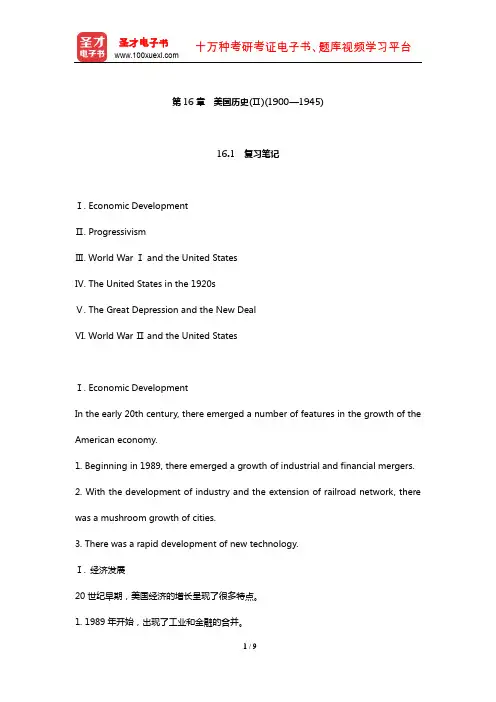
第16章美国历史(Ⅱ)(1900—1945)16.1 复习笔记Ⅰ. Economic DevelopmentⅡ. ProgressivismⅢ. World War Ⅰ and the United StatesⅣ. The United States in the 1920sⅤ. The Great Depression and the New DealⅥ. World War Ⅱ and the United StatesⅠ. Economic DevelopmentIn the early 20th century, there emerged a number of features in the growth of the American economy.1. Beginning in 1989, there emerged a growth of industrial and financial mergers.2. With the development of industry and the extension of railroad network, there was a mushroom growth of cities.3. There was a rapid development of new technology.Ⅰ. 经济发展20世纪早期,美国经济的增长呈现了很多特点。
1. 1989年开始,出现了工业和金融的合并。
2. 随着工业的发展和铁路网络的扩展,城市的数量开始迅速增长。
3. 新技术开始迅速发展。
Ⅱ. Progressivism1. With the development of the economy, there also arose a number of social problems.2. Pushed by the Progressive Movement, Presidents Theodore Roosevelt (1901-1909) and Woodrow Wilson (1913-1921) made a policy that the government should merely preserve order and protect property, leaving the control over the economy to the business people.3. President Wilson put forward his program of New Freedom and made many achievements.Ⅱ. 进步主义1. 随着经济的发展,也出现了一系列的社会问题。
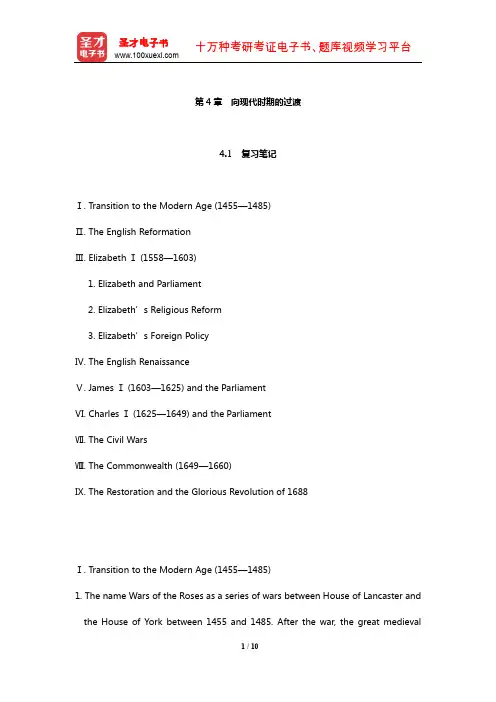
第4章向现代时期的过渡4.1 复习笔记Ⅰ. Transition to the Modern Age (1455—1485)Ⅱ. The English ReformationⅢ. Elizabeth Ⅰ (1558—1603)1. Elizabeth and Parliament2. Elizabeth’s Religious Reform3. Elizabeth’s Foreign PolicyⅣ. The English RenaissanceⅤ. James Ⅰ (1603—1625) and the ParliamentⅥ. Charles Ⅰ (1625—1649) and the ParliamentⅦ. The Civil WarsⅧ. The Commonwealth (1649—1660)Ⅸ. The Restoration and the Glorious Revolution of 1688Ⅰ. Transition to the Modern Age (1455—1485)1. The name Wars of the Roses as a series of wars between House of Lancaster and the House of York between 1455 and 1485. After the war, the great medievalnobility was much weakened and discredited. The king’s power now became supreme.2. Henry Tudor became Henry Ⅶ (1485—1509). He gave England very firm rule. Ⅰ. 向现代时期的过渡(1455—1485)1. 玫瑰战争指的是兰开斯特王朝和约克王朝之间从1455年到1485年的一系列战争。
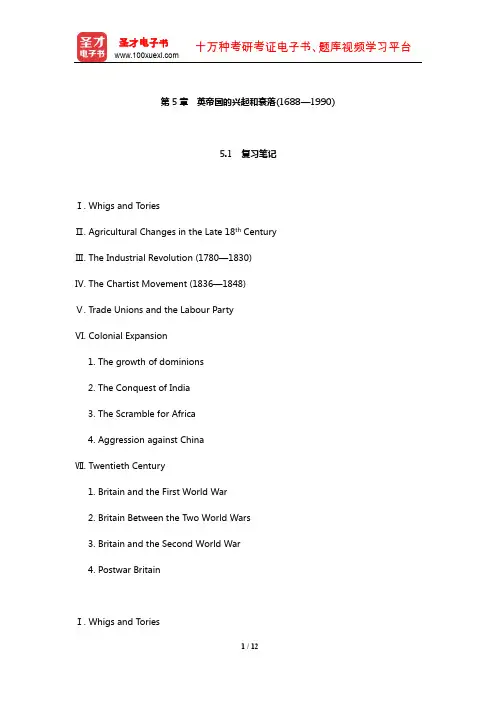
第5章英帝国的兴起和衰落(1688—1990)5.1 复习笔记Ⅰ. Whigs and ToriesⅡ. Agricultural Changes in the Late 18th CenturyⅢ. The Industrial Revolution (1780—1830)Ⅳ. The Chartist Movement (1836—1848)Ⅴ. Trade Unions and the Labour PartyⅥ. Colonial Expansion1. The growth of dominions2. The Conquest of India3. The Scramble for Africa4. Aggression against ChinaⅦ. Twentieth Century1. Britain and the First World War2. Britain Between the Two World Wars3. Britain and the Second World War4. Postwar BritainⅠ. Whigs and ToriesThese two party names originated with the Glorious Revolution (1688). The Whigs were to form a coalition with dissident Tories in the mid-19th century and become the Liberal Party. The Tories were the forerunners of the Conservative Party.Ⅰ. 辉格党和托利党这两大党派起源于光荣革命时期(1688)。
19世纪早期,辉格党和托利党联合,后来变成了自由党。
托利党是保守党的前身。
Ⅱ. Agricultural Changes in the Late 18th Century1. Farming was an important occupation in England in the 18th century.2. In the mid-18th century the population in England increased rapidly, depending on the countryside for food.3. Enclosure became more frequent after 1740 and climaxed during the turn of the century. Agricultural enclosure had good as well as bad results.Ⅱ. 18世纪晚期的农业变化1. 18世纪,农业是英国一个重要的职业。
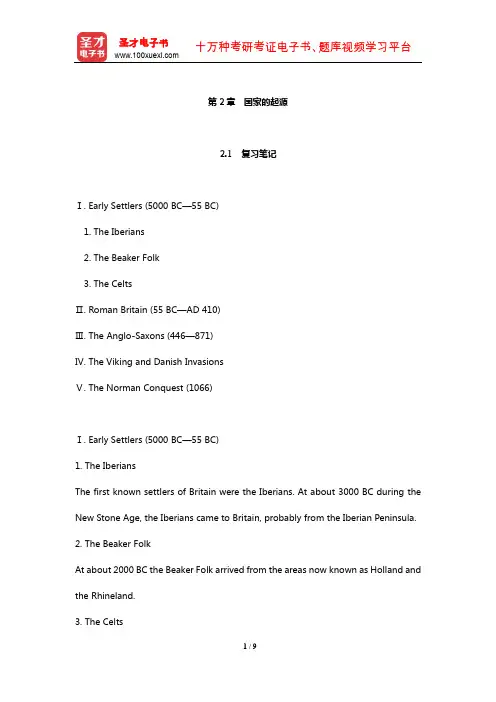
第2章国家的起源2.1 复习笔记Ⅰ. Early Settlers (5000 BC—55 BC)1. The Iberians2. The Beaker Folk3. The CeltsⅡ. Roman Britain (55 BC—AD 410)Ⅲ. The Anglo-Saxons (446—871)Ⅳ. The Viking and Danish InvasionsⅤ. The Norman Conquest (1066)Ⅰ. Early Settlers (5000 BC—55 BC)1. The IberiansThe first known settlers of Britain were the Iberians. At about 3000 BC during the New Stone Age, the Iberians came to Britain, probably from the Iberian Peninsula.2. The Beaker FolkAt about 2000 BC the Beaker Folk arrived from the areas now known as Holland and the Rhineland.3. The CeltsThe Celts began to arrive about 700 BC. They came to Britain in three main waves. Ⅰ. 早期的定居者(5000 BC—55 BC)1. 伊比利亚人英国最早的定居者是伊比利亚人。
大约公元前3000年,新石器时期,来自伊比利亚半岛的伊比利亚人来到了英国。
2. 宽口陶器人大约公元前2000年,宽口陶器人来到现在的荷兰和莱茵兰地区。
3. 凯尔特人公元前700年,凯尔特人来到英国。
他们分三批来到这里。
Ⅱ. Roman Britain (55 BC—AD 410)1. Julius Caesar, the great Roman general, invaded Britain for the first time in 55 BC. For nearly 400 years Britain was under the Roman occupation.2. The Romans also brought the new religion, Christianity, to Britain.3. The Romans had no impact on the language or culture of ordinary Britons.Ⅱ. 罗马统治时期(55 BC—AD 410)1. 尤里乌斯·凯撒,罗马将领,在公元前55年入侵英国。
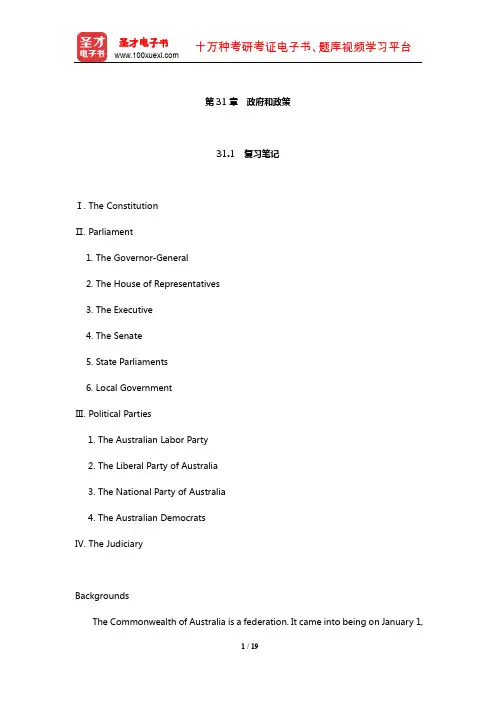
第31章政府和政策31.1 复习笔记Ⅰ. The ConstitutionⅡ. Parliament1. The Governor-General2. The House of Representatives3. The Executive4. The Senate5. State Parliaments6. Local GovernmentⅢ. Political Parties1. The Australian Labor Party2. The Liberal Party of Australia3. The National Party of Australia4. The Australian DemocratsⅣ. The JudiciaryBackgroundsThe Commonwealth of Australia is a federation. It came into being on January 1,1901 when the Commonwealth of Australia Constitution Act was enacted by the British Parliament.The Australian federation has a three-tier system of government: the federal parliament and government, six State parliaments and governments, and about 900 local governments at the city, town, municipal and shire level.The powers of the federal parliament are defined in a written Constitution. Australia is independent but still has constitutional links with Britain.Britain’s monarch is also formally Australia’s and is represented in Australia by the Governor-General and six State governors. They are head of state and formally chief executive.Apart from the federal system, the Constitution and Parliament, government of Australia is also carried out through other political institutions. They include the High Court, Cabinet, political parties, elections and the public service.The basic structure of Australian government is based on both the British and American models. There are also some significant Australian variations.背景1901年1月1日澳大利亚联邦宪法法案由英国议会颁布,澳大利亚联邦政府成立。
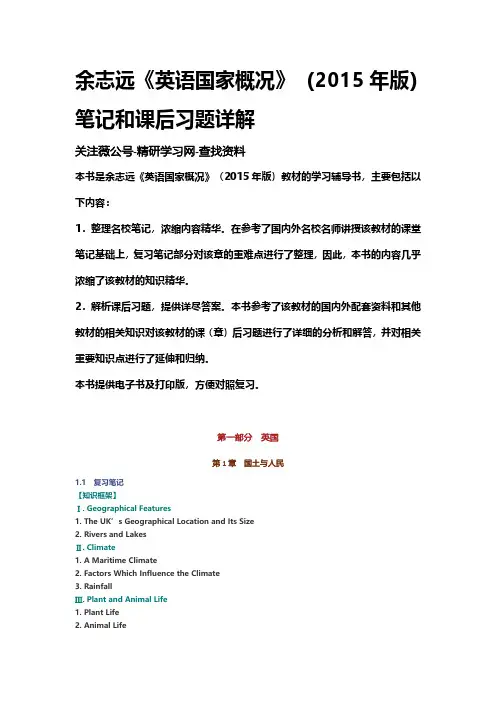
余志远《英语国家概况》(2015年版)笔记和课后习题详解关注薇公号-精研学习网-查找资料本书是余志远《英语国家概况》(2015年版)教材的学习辅导书,主要包括以下内容:1.整理名校笔记,浓缩内容精华。
在参考了国内外名校名师讲授该教材的课堂笔记基础上,复习笔记部分对该章的重难点进行了整理,因此,本书的内容几乎浓缩了该教材的知识精华。
2.解析课后习题,提供详尽答案。
本书参考了该教材的国内外配套资料和其他教材的相关知识对该教材的课(章)后习题进行了详细的分析和解答,并对相关重要知识点进行了延伸和归纳。
本书提供电子书及打印版,方便对照复习。
第一部分英国第1章国土与人民1.1复习笔记【知识框架】Ⅰ.Geographical Features1.The UK’s Geographical Location and Its Size2.Rivers and LakesⅡ.Climate1.A Maritime Climate2.Factors Which Influence the Climate3.RainfallⅢ.Plant and Animal Life1.Plant Life2.Animal Life1.Ethnic Groupsnguages3.Religion4.Urbanization5.Population Growth6.Migration Patterns【重难点归纳】1.Great Britain is made up of England,Scotland,and Wales.Together with Northern Ireland, it forms the United Kingdom of Great Britain and Northern Ireland.2.The total population of the UK was around63million,which is the third-largest in the European Union and the22nd-largest in the world.3.The UK is a developed country with considerable economic,cultural,military,scientific and political influence internationally.4.The UK’s capital is London,and it has other major cities including,Birmingham,Liverpool, and Manchester in England and so on.1.大不列颠由英格兰、苏格兰和威尔士组成。
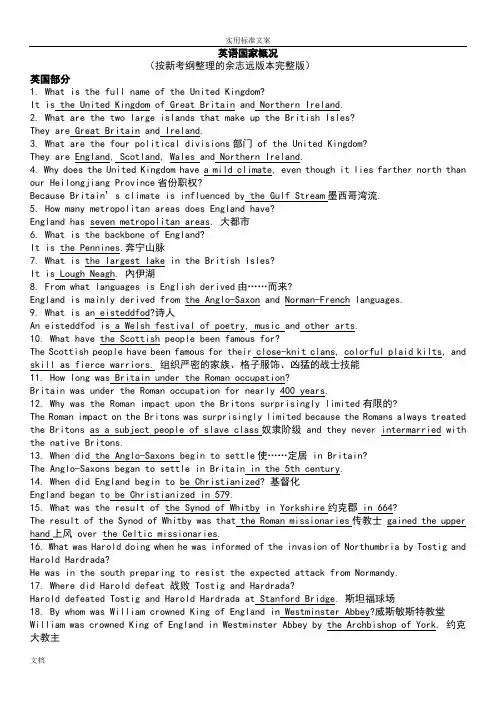
英语国家概况(按新考纲整理的余志远版本完整版)英国部分1. What is the full name of the United Kingdom?It is the United Kingdom of Great Britain and Northern Ireland.2. What are the two large islands that make up the British Isles?They are Great Britain and Ireland.3. What are the four political divisions部门 of the United Kingdom?They are England, Scotland, Wales and Northern Ireland.4. Why does the United Kingdom have a mild climate, even though it lies farther north than our Heilongjiang Province省份职权?Because Britain’s climate is influenced by the Gulf Stream墨西哥湾流.5. How many metropolitan areas does England have?England has seven metropolitan areas. 大都市6. What is the backbone of England?It is the Pennines.奔宁山脉7. What is the largest lake in the British Isles?It is Lough Neagh. 內伊湖8. From what languages is English derived由……而来?England is mainly derived from the Anglo-Saxon and Norman-French languages.9. What is an eisteddfod?诗人An eisteddfod is a Welsh festival of poetry, music and other arts.10. What have the Scottish people been famous for?The Scottish people have been famous for their close-knit clans, colorful plaid kilts, and skill as fierce warriors. 组织严密的家族、格子服饰、凶猛的战士技能11. How long was Britain under the Roman occupation?Britain was under the Roman occupation for nearly 400 years.12. Why was the Roman impact upon the Britons surprisingly limited有限的?The Roman impact on the Britons was surprisingly limited because the Romans always treated the Britons as a subject people of slave class奴隶阶级 and they never intermarried with the native Britons.13. When did the Anglo-Saxons begin to settle使……定居 in Britain?The Anglo-Saxons began to settle in Britain in the 5th century.14. When did England begin to be Christianized? 基督化England began to be Christianized in 579.15. What was the result of the Synod of Whitby in Yorkshire约克郡 in 664?The result of the Synod of Whitby was that the Roman missionaries传教士 gained the upper hand上风 over the Celtic missionaries.16. What was Harold doing when he was informed of the invasion of Northumbria by Tostig and Harold Hardrada?He was in the south preparing to resist the expected attack from Normandy.17. Where did Harold defeat 战败 Tostig and Hardrada?Harold defeated Tostig and Harold Hardrada at Stanford Bridge. 斯坦福球场18. By whom was William crowned King of England in Westminster Abbey?威斯敏斯特教堂William was crowned King of England in Westminster Abbey by the Archbishop of York. 约克大教主19. What did William do after he suppressed the Saxon risings in the north?He built a string of defense castles to ensure确定 his military军队 control of the whole country.20. Was the Norman Conquest the last successful invasion of England?Yes. The Norman Conquest was the last successful invasion of England because England has never been invaded since.21. Why did William I give his barons large estates房地产 in England?William I gave large estates to his barons because he wanted to get a promise of military service and a proportion of the land’s produce.22. What was the peculiar 特权feature特色 of the feudal system of England?All landowners, big and small, took the oath宣誓 of allegiance效忠 for the land they held, not only to their immediate直接 lord主, but also to the king.23. Why did William I have the Domesday Book compiled? 末日宣判书William I had the Domesday Book compiled because he wanted to have a reliable record of all his land, his tenants承租人 and their possessions拥有;财产 and to discover how much his tenants could be asked to pay by way of taxes.24. What was William I ’s policy towards the church?He wanted to keep it completely under his control, but at the same time to uphold支持鼓励维持 its power.25. Why did Henry II make Thomas Becket Archbishop大教主 of Canterbury?He thought that Thomas Becket would assist him in carrying out贯彻实施 legal reforms改革.26. What brought Henry II into collision 冲突矛盾with Thomas Becket, the Archbishop of Canterbury?The exceptional异常的 privileges特权 enjoyed by the clergy神职,牧师 brought Henry II into collision with Thomas Becket.27. What are the two aspects方面 of the Norman legacy遗产 that contributed to great domestic 国内 unrest 动荡in England in the 12th and 13th centuries?One was England’s possession占有 of territory领土 in France. The other was Norman adherence 依附坚持to Roman Catholicism.28. Who was the French national heroine during the Hundred Year’s War who helped the French to drive the English out of France?Joan of Arc.圣女贞德29. When did the government establish rules for the first time to keep down wages?The government established rules for the first time to keep down wages in 1351.30. How many peasant 农民in Kent and Essex were killed by Richard II ’s troops骑兵,军队?40,000 peasants in Kent and Essex were killed by Richard II’s troops.31. What were the emblems象征 of the Houses of York and Lancaster?The emblem of the House of York was a white rose and the emblem of the House of Lancaster was a red rose.32. What was the impact影响 of the Wars of the Roses on feudalism in England?The Wars of the Roses dealt处理分配 a death blow 打击to feudalism in England.33. How did Elizabeth I try to avoid troubling Parliament too often for pounds?She tried to avoid troubling Parliament by making strict economies at Court.34. What questions did Elizabeth I treat as personal and private?These questions were her religion, her marriage, her foreign policy, the succession to the throne, and her finance.35. How did Elizabeth I manage to maintain in friendly relationship with France?She managed to maintain a friendly relationship with France through her marriage alliances which were never materialized. 具体化36. When was Mary Queen of Scots executed? 执行Mary Queen of Scots was executed in 1587.37. What did the destruction毁灭消灭 of the Spanish Armada show?It showed England’s superiority as a naval power.38. What was the long-term result of the Gunpowder Plot? 火药阴谋The long-term result of the Gunpowder Plot has been an annual celebration of November 5, when a bonfire is lit to burn a guy and a firework display显示炫耀 is arranged.39. What was Puritanism清教 noted for因……而著名?It was noted for simple dress, high moral standards标准 and very egalitarian平等 attitudes.40. What is a constitutional宪法 monarchy君主?A constitutional monarchy is one whose power is limited by Parliament.41. What did the Whigs stand for in the early 19th century?They stood for a reduction减少 in Crown patronage, sympathy towards Nonconformists非国教, and care for the interests of merchants商人 and bankers.42. Why did changes in farming methods affect lives of millions in the 18th century? Changes in farming methods affected lives of millions in the 18th century England because village and agriculture were the backbone of England at that time.43. What did the land owners want to do in the late 18th and early 19th centuries? They wanted to replace the small farms cultivated on the “open-field” system by larger, economically more efficient farms with hedge-divided fields.44. Why was King George III nicknamed “Farmer George”?King George III was nicknamed “Farmer George” because he was very enthusiastic热衷 about agricultural 农业的changes at Winsor.45. What were the two events which most alarmed the British ruling classes 统治阶级in the closing decades数十年 of the 18th century?They were the American War of Independence and the French Revolution.46. When did the British begin to transport convicts罪犯 to Australia?The British began to transport convicts to Australia in 1788.47. What was the result of the general strike打击罢工 of 1926?The strike failed. The miners were forced to return to work with longer hours and lower wages even than before. Yet, outside the mining district, the strike seemed to have improved relations between the workers and the middle classes.48. Why did Edward VIII abdicate 退位in 1936 after a reign of 10 months?Edward VIII abdicated because he wanted to marry Wallis Simpson, a twice-divorced 离婚American.49. When did Britain finally become a full member of the European Economic Community? 欧共体Britain finally became a full member of the European Economic Community in January,1973.50. Why was Mrs. Thatcher removed from office in 1990?It was because of her opposition反对 to European Union and her imposition征收强加 of an extremely unpopular flat-rate 固定税率“poll tax”人头税 in place of property taxes to payor local government service.61. Where does the Sovereign’s coronation加冕 take place?发生举行The Sovereign’s coronation takes place at Westminster Abbey in London.62. When is the Sovereign’s birthday officially celebrated?It is officially celebrated in June every year.63. What does the Duke of Edinburgh do when the Queen pays state visits to foreign governments? He accompanies陪同 her.64. Where does the Queen’s expenditure arising from public duties come from?The Queen’s expenditure arising from public duties comes from the Civil List and government departments.65. What does the term “parliament” originally最初 mean?The term “parliament” originally means a meeting for a parley or discussion.66. What is the main function of the House of Lords?The main function of the House of Lords is to bring the wide experience of its members into the process of law-making.67. What is the Speaker’s task in the House of Commons?His task is to preside over the House and enforce the rules of order. 执行顺序规则68. How many counties are there in England and Wales?There are 53 counties in England and Wales.69. What are the three island areas where single-tier authorities当局官方 were introduced in Scotland?They are the Orkneys, the Shetlands and the Western Isles.70. How do local authorities in Great Britain raise revenue?They raise revenue 税收through the council tax.81. Are British people obliged to 不得不use the National Health Service?国民医疗保健制度No. They are not obliged to use the service.82. What are services for elderly people aimed at?Services for elderly people are aimed at helping them live at home whenever possible. 83. What is the aim of the social security system?The aim of the social security is to secure a basic standard of living for people in financial need.84. At what age do men and women generally retire退休?Men generally retire at the age of 65, and women at the ate of 60.85. What are the two established churches in Britain?They are the Church of England in England and the Church of Scotland in Scotland.86. How many provinces职权省份 does the Church of England have?The Church of England has two provinces: Canterbury and York.87. When were the first women priests ordained in Britain?They were ordained in March 1994.88. Who founded the Salvation Army in the East of London in 1865?William Booth, a great follower of John Wesley, founded the Salvation Army.89. Where do the people in London go to see the Christmas decorations?They go to Oxford Street, Regent Street and Piccadilly to see the Christmas decorations.90. Why is December 26th called “Boxing Day”?December 26th is called Boxing Day because it was formerly the custom to give “Christmasboxes”, or gifts of money, to servants and tradesmen商人 on this day.91. How many kinds of state secondary schools 国立公立are there in Great Britain? Three. They are grammar school, secondary modern school and comprehensive school.92. When was the Open University founded? When did it begin its first courses?It was founded in 1969, and it began its first courses in 1970.93. Why is the Open University so named?It is so named because it is “open” to all to become students.94. How much money is spent on press advertising平面广告every year in Great Britain? About £5,100 million.95. How much time do British people spend a day watching television?People spend an average of over three and a half hours a day watching television.96. How are the state-run television channels BBC1 and BBC2 financed?They are financed from the sale of television licences.97. How are independent channels ITV and C4 funded?They are funded entirely by advertising. 广告98. When did the BBC begin to provide regular television broadcasts?The BBC began to provide regular television broadcasts in 1936.99. Which sport is regarded as typically English?Cricket 板球is the most typically English sport.100. What is a “copyright” library?It is a library which is entitled to receive a free copy of every book published in the United Kingdom.美国部分1. How does the United States rank among the countries of the world in population and area? The United States of America is the third-largest country in the world in population and the fourth-largest country in area.2. What are the two major mountain ranges in the United States?They are the Appalachian Highlands阿巴拉契亚山脉 and the Rocky Mountains. 落基亚山脉3. What is the Continental Divide, or Great Divide?The Continental Divide, or Great Divide, is an imaginary line that separates streams that flow into the Pacific Ocean from those that flow into the Atlantic.4. What are the five Great Lakes of the United States?They are Erie, Huron, Michigan, Ontario, and Superior. 伊利湖、休伦湖、密歇根、安大略、苏必利尔湖5. How many geographical regions can be found in the United States? What are they? There are seven geographical regions in the United States. They are New England, the Middle Atlantic States, the southern States, the Midwestern States, the Rocky Mountain states, the Southwestern States, and the Pacific Coast States and the New States. 在美国有七个地理区域。
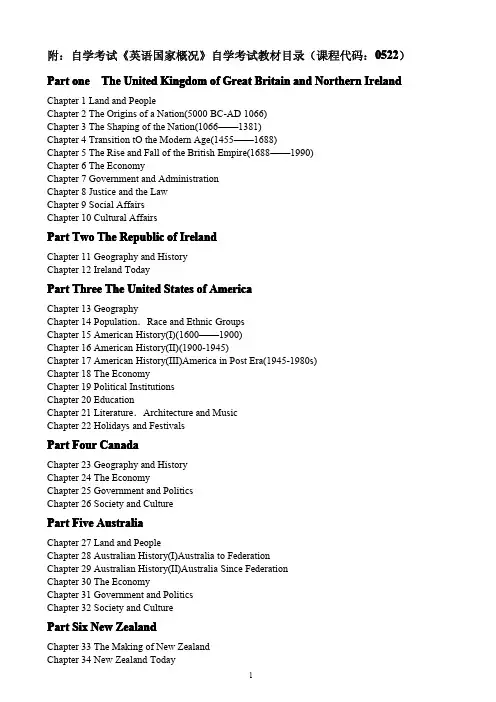
附:自学考试《英语国家概况》自学考试教材目录(课程代码:0522)Part one The United Kingdom of Great Britain and Northern Ireland Chapter1Land and PeopleChapter2The Origins of a Nation(5000BC-AD1066)Chapter3The Shaping of the Nation(1066——1381)Chapter4Transition tO the Modern Age(1455——1688)Chapter5The Rise and Fall of the British Empire(1688——1990)Chapter6The EconomyChapter7Government and AdministrationChapter8Justice and the LawChapter9Social AffairsChapter10Cultural AffairsPart Two The Republic of IrelandChapter11Geography and HistoryChapter12Ireland TodayPart Three The United States of AmericaChapter13GeographyChapter14Population.Race and Ethnic GroupsChapter15American History(I)(1600——1900)Chapter16American History(II)(1900-1945)Chapter17American History(III)America in Post Era(1945-1980s)Chapter18The EconomyChapter19Political InstitutionsChapter20EducationChapter21Literature.Architecture and MusicChapter22Holidays and FestivalsPart Four CanadaChapter23Geography and HistoryChapter24The EconomyChapter25Government and PoliticsChapter26Society and CulturePart Five AustraliaChapter27Land and PeopleChapter28Australian History(I)Australia to FederationChapter29Australian History(II)Australia Since FederationChapter30The EconomyChapter31Government and PoliticsChapter32Society and CulturePart Six New ZealandChapter33The Making of New ZealandChapter34New Zealand Today第一部分英国概况第一章国土和人民第二章英国民族起源(5000BC~AD1066)第三章民族的形成(1066~1381)第四章向现代过渡时期的英国(1455~1688)第五章大英帝国的兴衰(1688~1990)第六章经济第七章英国政府机构第八章法律与司法机构第九章英国社会第十章英国文化第二部分爱尔兰概况第十一章爱尔兰地理与历史第十二章今日爱尔兰第三部分美国概况第十三章美国地理第十四章人口、种族和种族集团第十五章美国历史(I)(1600~1900)第十六章美国历史(II)(1900~1945)第十七章美国历史(III)二次大战后的美国(1945-1980S)第十八章美国经济第十九章政治体制第二十章教育第二十一章文学、建筑和音乐第二十二章假日和节日第四部分加拿大概况第二十三章加拿大地理与历史第二十四章加拿大经济第二十五章加拿大政府与政治第二十六章加拿大的社会与文化第五部分澳大利亚概况第二十七章土地与人民第二十八章澳大利亚联邦成立之前的历史第二十九章澳大利亚联邦成立以来的历史第三十章澳大利亚经济第三十一章澳大利亚政府与政治制度第三十二章澳大利亚社会与文化第六部分新西兰概况第三十三章新西兰地理与历史第三十四章今日新西兰附件:《英语国家概况自学考试大纲》的考核目标Part One The United Kingdom of Great Britain and Northern Ireland Chapter1Land and PeopleI.Different Names for Britain and its PartsChapter2The Origins of a NationI.Early Settlers3.The CeltsII.Roman BritainIII.The Anglo-SaxonsⅣ.The Viking and Danish InvasionsV.The Norman ConquestChapter3The Shaping of the NationⅠ.Norman Rule1.William’s RuleⅡ.The Great Charter and the Beginning of Parliament1.The Great CharterⅢ.The Hundred Years’War with FranceⅣ.The Black Death and the Peasant UprisingChapter4Transition to the Modern AgeⅠ.Transition to the Modern AgeⅡ.The English ReformationⅢ.Elizabeth I1.Elizabeth and Parliament2.Elizabeth’s Religious Reform3.Elizabeth’s Foreign PolicyⅣ.The English RenaissanceVII.The Civil WarsVIII.The CommonwealthIX.The Restoration and the Glorious Revolution of1688Chapter5The Rise and Fall of the British EmpireⅠ.Whigs and ToriesⅡ.Agricultural Changes in the Late18th CenturyⅢ.The Industrial RevolutionⅣ.The Chartist MovementVII.Twentieth Century1.Britain and the First World War3.Britain and the Second World War4.Postwar BritainChapter7Government and AdministrationⅠ.The MonarchyⅡ.Parliament1.The House of Lords2.The House of CommonsⅢ.The Cabinet and MinistryⅣ.The Privy CouncilChapter8Justice and the LawIV.The JudiciaryV.PoliceChapter9Social AffairsⅠ.Health and Social Services1.The National Health ServiceⅢ.Religion1.Established churchesⅣ.Festivals and Public Holidays1.Christian festivals2.Other festivals3.Public holidaysChapter10Cultural AffairsⅠ.Education3.Higher educationⅡ.The Media1.NewspapersⅢ.SportsⅣ.The Arts3.DramaPart Two The Republic of Ireland Chapter11Geography and HistoryI.Geographical FeaturesII.Climate and WeatherIII.Population and ReligionIV.Historical backgroundPart Three The United States of America Chapter14Population,Race and Ethnic GroupsI.IntroductionIV.Racial and Ethnic Minorities1.BlacksChapter15American History(I)Ⅰ.Discovery of the New WorldⅡ.The Colonial PeriodⅢ.The War of IndependenceⅣ.A New Form of GovernmentⅥ.Territorial Expansion and Westward MovementⅦ.The Civil WarⅧ.Rapid Growth of Capitalism after the Civil WarChapter16American History(II)Ⅰ.Economic DevelopmentⅡ.ProgressivismⅢ.World War I and the United StatesⅣ.The United States in the1920sⅤ.The Great Depression and the New DealⅥ.World War II and the United StatesChapter17American History(III)Ⅰ.The Origins of the Cold WarⅡ.The Truman Doctrine and the Marshall Plan V.McCarthyismVII.American Society During the Postwar Boom:1945-1960s VIII.The Cuban Missile CrisisIX.The Vietnam WarX.United States’Relations with ChinaXII.Watergate ScandalChapter18The Economy(Two paragraphs)Ⅰ.The Economic System of the United StatesV.Foreign TradeVI.Problems in the U.S.EconomyChapter19Political InstitutionsⅠ.The U.S.Constitution1.The Federal system2.Separation of powers:checks and balances3.Provisions for amendmentⅡ.The Executive Branch1.The Presidency2.Presidential PowersⅢ.The Legislative Branch2.Powers of the House and Senate3.Officers of the Congress4.Functions of the CongressⅤ.Political Parties(two-party system)Chapter20EducationⅠ.Characteristics of American EducationⅡ.Elementary and Secondary EducationⅢ.Higher EducationⅤ.Education ReformsChapter21Literature,Architecture and MusicⅠ.American Literature1.Washington Irving2.Emerson and Hawthorne3.Mark Twain4.Whitman and Dickinson5.Theodore Dreiser6.T.S.Eliot7.Ernest Hemingway8.Hughes and WrightChapter22Holidays and FestivalsⅠ.New Year’s DayIV.Valentine’s DayVI.Easter DayVIII.Independence DayIX.HalloweenXI.Thanksgiving DayⅩII.Christmas DayPart Four Canada Chapter23Geography and HistoryⅠ.Geographic Features4.Geographic regionsⅡ.The making of Canada1.The European discovery3.Self-government and Confederation4.The Canadian nationChapter26Society and CultureI.Canadian Society1.Population2.Immigration3.Bilingualism4.MulticulturalismPart Five Australia Chapter27Land and peopleⅠ.The Geographical Structure1.The Great Western Plateau2.The Eastern Highlands3.The Central Eastern LowlandsⅡ.Climate3.Causes and effects of the hot and dry climate Ⅳ.People1.Population2.Population density and distributionⅤ.Australia’s Built Environment1.Sprawling cities2.Rural areasⅥ.Political Divisions1.New South Wales2.Victoria3.Queensland4.South Australia5.West Australia6.TasmaniaChapter32Society and CultureIV.Australian Culture1.Aboriginal culture2.Modern Australian culturePart Six New Zealand Chapter33The Making of New ZealandⅠ.GeographyⅡ.ClimateⅢ.Plants and AnimalsⅣ.Historical Background2.The Treaty of Waitangi1840VI.Maoritanga5.Race relations《<英语国家概况>自考辅导》目录(配合《英语国家概况》余志远,外语教学与研究出版社2005版)Part One The United Kingdom of Great Britain and North IrelandChapter1Land and People(英国的国土与人民)Chapter2The origins of the Nation(国家的起源)Chapter3The Shaping of the Nation(英国的形式)Chapter4Transition to the Modern Age(向现代过度的英国)Chapter5The Rise and Fall of the British Empire(英帝国的兴衰)Chapter6The Economy(英国经济)Chapter7Government and Administration(英国政府机构)Chapter8Justice and the Law(法律和司法机构)Chapter9Social Affairs(社会事务)Chapter10Cultural Affairs(文化事务)Part Two The Republic of IrelandThe Republic of Ireland(爱尔兰共和国)Part Three United States of AmericaChapter1A Survey of American Natural Circumstances and Geography(美国的自然环境和地理概况)Chapter2People and Ethnic Groups(人口和名族)Chapter3American History(Ⅰ)(1600-1900)(美国历史)Chapter4American History(Ⅱ)(1900-1945)(美国历史)Chapter5American History(Ⅲ)(1945-1980s’)(美国历史)Chapter6American Literature(美国文学)Chapter7American Economy(美国经济)Chapter8American Politics(美国政治)Chapter9American Education(教育)Chapter10American Music,Architecture and Newspaper(音乐、建筑和报纸)Chapter11Holidays and Festivals(美国的节假日)Part Four CanadaChapter1The History of Chanada(加拿大的历史)Chapter2Canadian Geography(加拿大地理)Chapter3The Economy(经济)Chapter4Government and Politics(政府和政治)Chapter5Society and Culture(社会与文化)Part Five AustraliaChapter1Australia”s Land and People(澳大利亚的国土与人口)Chapter2Australian History(澳大利亚历史)Chapter3Australian Economy(澳大利亚经济)Chapter4Polotical System(澳大利亚政治体制)Chapter5Society and Culture(社会与文化)Part Six New ZealandChapter1The making of New of New Zealand(地理与历史)Chapter2New Zealand Today(今日新新西兰)。
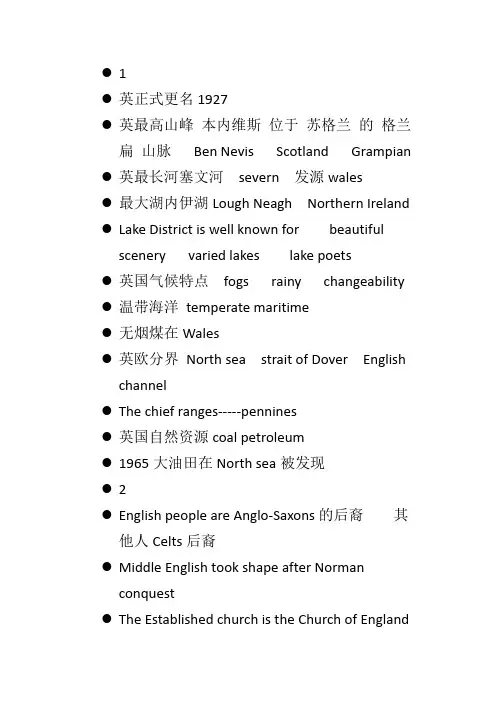
●1●英正式更名1927●英最高山峰本内维斯位于苏格兰的格兰扁山脉Ben Nevis Scotland Grampian●英最长河塞文河severn发源wales●最大湖内伊湖Lough Neagh Northern Ireland ●Lake District is well known for beautifulscenery varied lakes lake poets●英国气候特点fogs rainy changeability ●温带海洋temperate maritime●无烟煤在Wales●英欧分界North sea strait of Dover Englishchannel●The chief ranges-----pennines●英国自然资源coal petroleum●1965大油田在North sea被发现●2●English people are Anglo-Saxons的后裔其他人Celts后裔●Middle English took shape after Normanconquest●The Established church is the Church of England●Roman catholic church doesn’t belong to Freechurches●复活节纪念耶稣复活resurrection●北爱尔兰tormented by differences betweenprotestant 新教majority and catholic天主minority●英国主要说English Gaelic Welsh●宗教Non-christian communities----JewsMoslemsBuddhists●4●英社会习俗基于christian tradition●英国没有成文宪法老式政府●英政府established on the basis of constitutionalmonarchy●经济账单---------下议院●政府有了下议院允许才能花钱●政府大臣必须是国会成员对国会负责●行政公民禁止被选为国会成员●当今君主Queen Elizabeth II Prince Charles●国会立法机构legislative authority●国会Parliament包括the monarch The Houseof Commons The House of Lords●The House of Commons-----Mr. Speaker TheHouse of Lords----Lord chancellor●国会功能debating making lawssupervising the gowernment and finance●政府组成the Prime Minister and otherministers who are responsible to parliament●首相controls the Cabinet and the Parliament●Areas has its own elected council●Majority●公民上诉最高到上议院●Conservative party保守党Tory●Labour party工党Whig●Liberal Democrats民主自由党●5●二战后二战开始轮流执政●英国大选5年一次●下议院人多的政党组成政府●Scotland Yard--------CID 刑事侦缉部●大选时分为651个选区每区选一个下议院成员●6●Earliest settlers were the Iberians伊比利亚人and Celts●Celts 来自Upper Rhineland●410A.D.罗马军队撤回英国留下welshChristianityroman roads cities●Angle----Northumbria Mercia East Anglia ●Jutes----Kent●Saxon----Essex Sussex Wessex●Late 8th Danes进攻英格兰海岸●末日审判书Doomsday Book 记录每人财富●大宪章The Great Charter feudal lordinterest●1265 simon第一次召集各级议会All EstatesParliament 史称典型议会the ModelParliament●5th三个日耳曼Teutonic从Denmark and LowCountries迁移到英国●封建制度Feudalism建立after NormanConquest●7●1337百年战争爱德华三世发起against Francefor the French crownfeudal war trade war封建社会瓦解标识之一●黑死病一定程度上带来higher wages greaterfreedom shortage of labor●1455玫瑰战争between Lancastrians red andYorkists white Feudalism was weakenedIntermittently●都德王朝The House of Tudor 建立于1485●Capitalism rise Feudalism decline●资产阶级革命bourgeois revolution 17th●第一次内战中The Kings men werecalled Cavalier骑士The parliaments men were called Roundhead圆颅党●1660查理斯二世复辟●1688光荣革命a bloodless coupdétatWilliam ofOrange 称王确立君主立宪制constitutionalmonarchy●8●英工业革命在textile industry 1760s—1840sindustrial●哈格里夫斯---珍妮纺纱机spinning jenny●Richard阿克莱特---水利织布机spinningmachine run by water●Edmund卡特莱特---自动织布机the power loom ●瓦特---the steam engine●Productivity increased cities sprang up●Among the working people caused miseries anddisasters●9●大英帝国开始于第一块殖民地Newfoundland的建立没落于二战后●印度兵变杀死英国官员销毁要塞释放政治犯●帝国主义imperialism territorialexpansion,monopoly,export of capital●Triple Alliance 同盟国Germany, Austria-Hungary,and Italy●Triple Entente 协约国France, Russia and Britian ●日本偷袭珍珠港1941●The British commonwealth of nations is a phonyorganization●1970s 英国经济stagflatio-不景气●撒切尔主义Thatcherism去国有化denationalization●中英建交1972●east india company enlist army , enforce law,declare war, make peace in India●两次世界大战英国对外政策仇-hostility前苏联对法西斯不干预non-intervention和绥靖政策appeasement●10●美国大陆部分位于北美中部面积第四●Alaska最大州内战后从俄罗斯买入●Rocky Mountains 分界●Mississippi not international●Hudson through new York●Michigan完全在美国内部●尼亚加拉瀑布Niagara Falls—美加分界—lakeErie and lake Ontario●弗罗里达亚热带semitropical●Oregon and Washingtonrainiest●美国四分之三铁矿来自Lake Superior●Western mountain ranges 富含无铁金属●美国东部高地Appalachian Mountain●美山脉rocky mountain coast mountains●美国中部vast plains 平原●11●美国人大多是WASPs Protestants新教徒数量最多●中国人shipped to US as ”coolies”●少数民族-拉丁裔美国人Hispanics最多Spanish--black第二english●加利福尼亚California人口最多●美国人European origin●Blake people descended from Negro slavesimported from Africa●1863 lincoln’sEmancipation Proclamation解放宣言●13●1787宪法在费城Philadelphia●美国总统行政executive power●立法权legislative--国会congress 行政权executive--总统司法权judicial--最高法院Supreme Court●总统对国会立法可以否决国会可以否决总统2/3票数●总统未经参议院上院senate允许可以自主签署executive agreement●department of state国务院advises 总统onforeign relations●representative每2年一次●弹劾impeachment由下院the House提出上院裁决●两原则the federal system the separation ofpowers●财政部部长Finance Minister●国防部长Defense Minister●国务卿Secretary of state是国务院部长●司法部长Attorney General 是司法部部长●参议院主席Vice-president●下议院主席Mr. Speaker●14●State-county-city town village●民主党Democratic Party Donkey●共和党Republican Party Elephant●美国大选4年一次一共538张选票(参议院100众议院435 哥伦比亚特区3)●第一个星期二November第三个星期一October ●众议院3选一总统参议院2选一副总统●Legislature the most part of state governmentconsists of 2 houses●Governor elected by popular vote●投标的时候不是投给总统而是投给总统选举人-electors●Senator Representatives Congressmen●15●哥伦布意大利人Italian 1492发现新大陆”india”●哥伦布发现的新大陆-美洲was named after亚美瑞格.韦斯普奇Amerigo Vespucci●英国殖民地最早在Jamestown●清真徒Puritans sailed for America on Mayflower自称Pilgrims殖民最早在Plymouth自称New England●美国最早原著居民American Indians from Asiacross the Bering Strait●The New England Colonies became a center forlumbering shipping fishing●The Central Colonies became a region of smallfarms●The Southern Colonies developed a plantationsystem with the exploitation of slave labor●16●独立战争第一枪--莱克星顿转折点--萨拉托加●内战炮击萨姆特要塞●印法战争是英国与法国之间,开始于OhioValley●1774第一次大陆会议●1775第二次大陆会议在费城举行●马克思称独立宣言是“第一个关于个人权利的宣言”●萨拉托加Saratoga战役的胜利是美国独立战争转折点●1787制宪会议在费城举行●James Madison被称为宪法之父●17●路易斯安那Louisiana是从法国France手里买进●美墨战争---德克萨斯加利福尼亚亚利桑那内华达无Oregon俄勒冈华盛顿迫使英国割让●19th中叶结束领土扩张●Compromise of 1850 solve the California●美国吞并墨西哥的Texas in 1845●1867从沙皇俄国Czarist Russia 买进Alaska●Uncle Tom’ Cabin -----Harriet Beecher Stowe●The Jungle----Upton Sinclair 描述肉类包装●共和党Republican Party 建于1854●六州退出联邦建立美国南部同盟ConfederateStates of America●1861叛军炮击塞姆特要塞Sumter 内战爆发●1862解放黑奴宣言Emancipation Proclamation ●18●夏威夷原属西班牙●美帝国主义重工业发展资本集中海外扩张●美西战争加剧了美国对美洲的干预●1979中美建交●自由资本主义Competitive capitalism转变为垄断资本主义monopoly capitalism●美西战争为抢夺Cuba 割让Cuba.Puerto Rico.Guan. Philippines●1917参加一战●1941 珍珠港Pearl Harbor in Hawaii●二战后对苏联Cold War and containment牵制。
第22章假期和节日22.1 复习笔记Ⅰ. New Year’s DayⅡ. Martin Luther King’s Day (Third Monday of January)Ⅲ. Lincoln’s Birthday (February 12)Ⅳ. Valentine’s Day (February 14)Ⅴ. Washington’s Birthday (February 22)Ⅵ. Easter Sunday (A Sunday in March or April)Ⅶ. Memorial Day (Last Monday in May)Ⅷ. Independence Day (July 4)Ⅹ. Veterans’ Day (November 11)Ⅺ. Thanksgiving Day (Fourth Thursday of November)Ⅻ. Christmas Day (December 25)Ⅰ. New Year’s Day1. Actually the celebration of this holiday begins the night before—on New Year’s Eve. In many places people stay up late to watch the old year out and the new year in.2. On the first day of the New Year, there are a lot of activities. Mummers Paradeheld in Philadelphia is one of the most popular New Year’s Day activit ies.Ⅰ. 元旦1. 事实上,新年的庆祝活动开始于新年前夜。
在很多地方,人们熬夜守岁,共同迎接新的一年。
2. 新年的第一天,有很多的活动。
第33章新西兰的组成33.1 复习笔记Ⅰ. GeographyⅡ. ClimateⅢ. Plants and AnimalsⅣ. Historical Background1. Before 18402. The Treaty of Waitangi 18403. After 18404. The 1870s and after5. Social changes6. The 1930s and 1940s7. After World War ⅡⅤ. Notable New ZealandersⅥ. Maoritanga1. Origins2. Traditional history3. Everyday life before 18404. Society5. Race relations6. Recent developmentsⅠ. Geography1. New Zealand is in the Southern Pacific Ocean, halfway between the equator and the South Pole.2. It has two main Islands: North Island and South Island.3. North and South Islands are long and narrow; from Cape Reinga in the far north to Bluff at the very south of South Island is 1,770 km.4. New Zealand is just west of the International Date Line, so it is the first country to get the new day. It has only one time zone.5. The highest peak, Mt Cook, 3,764 meters, is in the centre of the mountain range, which is called the Southern Alps.6. In North Island the central plateau is dominated by 3 volcanic mountains. Ruapehu and Ngaurohoe are active volcanoes. The third mountain, Tongariro is dormant.7. The centre of North Island is a volcanic and geothermal area. There are pools of boiling mud and boiling water.8. Lake T aupo is the largest lake in New Zealand.9. The largest river is the Clutha in South Island.10. The two largest North Island rivers, the Waikato and the Wanganui.11. Apart from occasional storms and flooding, and droughts in some areas,earthquakes and volcanoes are the most serious potential natural disasters. Ⅰ. 地形1. 新西兰位于太平洋南部,在赤道和南极点正中间。
第8章司法和法律8.1 复习笔记Ⅰ. Criminal ProceedingsⅡ. Criminal Courts1. England and Wales2. Scotland3. Northern IrelandⅢ. Civil Courts1. England and Wales2. Scotland3. Northern IrelandⅣ. The JudiciaryⅥ. Treatment of OffendersⅠ. Criminal Proceedings1. All criminal trials are held in open court.2. Every accused person has the right to employ a legal adviser to conduct his defence.3. In criminal trials by jury, the judge passes sentence, but the jury decides the issueof guilt or innocence.Ⅰ. 刑事诉讼1. 所有的刑事审判都是在公开法庭上举行的。
2. 每一个被告都有权力雇佣一个法律顾问为其进行辩护。
3. 在有陪审团的审判中,法官负责宣判,但是由陪审团决定嫌疑人是否有罪或清白。
Ⅱ. Criminal Courts1. England and Wales①Criminal courts in England and Wales include: Magistrates’ Courts which try summary offences (the less serious offences and the vast majority of criminal cases) and “either way” offences (theft, the less serious cases of burglary and some assaults).②Youth Courts try most cases involving people under 18.③The Crown Court which tries the most serious offences and “either way” offences referred to it by magistrates.Ⅱ. 刑事法庭1. 英格兰和威尔士①英格兰和威尔士的刑事法庭包括治安法院(处理不太严重的违法行为和大部刑事案件)和“任意方式”罪行(偷窃,不太严重的入室行窃和袭击)。
The United Kingdom of Great Britain and Northern Ireland英国的历史分四部分:1.The Origins of a Nation2.The Shaping of the Nation3.Transition to the Mordern Age4.The Rise and Fall of the British EmpireHistory of UKEarly settlers -> Roman Britain -> Anglo-Saxons -> the Viking and Danish Invations -> the Norman ConquestNorman Rule -> the Great Charter -> the Hundred Years' War with France -> the Blackdeath and the peasant uprisingthe English Reformation -> Elizabeth I -> the English Renaissance -> James I -> Charles I -> the Civil War -> the commonwealth -> the Glorius RevolutionTwo parties (Whigs and Tories) -> Agricultural changes -> the Industrial Revolution -> the Chartist Movement -> Trade unions and the Labour Party -> Colonial Expansion -> in the two World WarsChapter 1 Land and People第一部分:Different Names for Britain and its Parts1. 选择题/ 简答题:The official name of the United Kingdom is the United Kingdom of Great Britain and Northern Ireland2.选择题/ 简答题:The British Isles are made up of two large islands-Great Britain (the larger one) and Ireland, and hundreds of small ones.There are three political divisions on the island of Great Britain:England, Scotland and Wales3.简答题:Why do people tend to use "England" and "English" when they mean "Britain" and "British"?England is the largest, most populous and generally speaking the richest section. So people tend to use “England” and “English” when they mean “Britain” and “British”.4.名词解释:the Commonwealth of Nations 或the British CommonwealthThe Commonwealth is a free association of independent countries that were once colonies of Britain. Member nations are joined together economically and have certain trading arrangements. The Commonwealth has no special powers.。
英语国家概况课后习题答案解析(完整版)一、选择题(答案在下面)I. Choose the one that best completes each of the following statements.1.The two main islands of the British Isles are .A. Great Britain and IrelandB. Great Britain and ScotlandC. Great Britain and WalesD. Great Britain and England2. is the capital city of Scotland.A. BelfastB. EdinburghC. AberdeenD. Cardiff3.According to a 2005 estimate, Britain now has a population of overmillion.A. 160B. 600C. 60D. 164.Among the four parts of the United Kingdom, is the smallest.A. EnglandB. ScotlandC. WalesD. NorthernIreland5.Almost a quarter of the British population lives in England.A. northeasternB. southeasternC. northwesternD. southwestern6.English belongs to the group of Indo-European family of languages.A. CelticB. Indo-IranianC. GermanicD. Roman7.The introduction of Christianity to Britain added the first element ofwords to English.A. Danish and FinnishB. Dutch and GermanC. French and ItalianD. Latin and Greek8.The evolution of Middle English was reinforced by the influence.A. NormanB. DutchC. GermanD. Danish9.Samuel Johnson’s dictionary was influential in establishing a standard formof .A. grammarB. handwritingC. spellingD.pronunciation10.At present, nearly of the world’s population communicate in English.A. halfB. a quarterC. one thirdD. one fifth11.The attack on Rome ended the Roman occupation in Britain in 410.A. NormanB. DanishC. CelticD. Germanic12.By the late 7th century, became the dominant religion in England.A. Celtic ChristianityB. Anglo-Saxon ChristianityC. Germanic ChristianityD. Roman Christianity13.Westminster Abbey was built at the time of .A. St. AugustineB. Edward the ConfessorC. William the ConquerorD. Alfred the Great14.The marked the establishment of feudalism in England.A. Viking invasionB. signing of the Magna CartaC. Norman ConquestD. Adoption of common law15.The end of the Wars of the Roses led to the rule of .A. the House of ValoisB. the House of YorkC. the House of TudorD. the House of Lancaster16.The direct cause for the Religious Reformation was King Henry VIII’s effortto .A. divorce his wifeB. break with RomeC. support the ProtestantsD. declare his supreme power overthe church17.The English Civil War broke out in 1642 between .A. Protestants and PuritansB. Royalists and ParliamentariansC. nobles and peasantsD. aristocrats and Christians18. was passed after the Glorious Revolution.A. Bill of RightsB. Act of SupremacyC. Provisions of OxfordD. Magna Carta19.The Industrial Revolution was accomplished in Britain by the middle of thecentury.A. 17thB. 18thC. 19thD. 20th20.Britain faced strong challenges in its global imperialdominance by thebeginning of the century.A. 17thB. 18thC. 19thD. 20th21.The British government is characterized by a division of powers between threeof the following branches with the exception of the .A. judiciaryB. legislatureC. monarchyD. executive22.The importance of the British monarchy can be seen in its effect on .A. passing the billsB. advising the governmentC. political partiesD. public attitude23.As a revising chamber, the House of Lords is expected to the House ofCommons.A. rivalB. complementC. criticizeD. inspect24.British Cabinet works on the principle of .A. collective responsibilityB. individual responsibilityC. defending the collectivismD. defending the individuals25.The main duty of the British Privy Council is to .A. make decisionsB. give adviceC. pass billsD.supervise the Cabinet26.In Britain, the parliamentary general election is held every years.A. threeB. fourC. fiveD. six27. has a distinct legal system based on Roman law.A. WalesB. EnglandC. ScotlandD. Northern Ireland28.Generally speaking, the British Parliament operates on a system.A. single-partyB. two-partyC. three-partyD.multi-party29.The policies of the Conservative Party are characterized by pragmatismand .A. government interventionB. nationalization of enterprisesC. social reformD. a belief in individualism30.The Labor Party affected the British society greatly in that it .A. set up the National Health ServiceB. improved publictransportationC. abolished the old tax systemD. enhanced the economic development31.The British economy achieved global dominance by the .A. 1860sB. 1870sC. 1880sD.1890s32.In , the British Parliament passed two important acts to establish awelfare state.A. 1945B. 1946C. 1947D. 194833.The in the early 1970s worsened an already stagnant economy in Britain.A. oil crisisB. high inflation ratesC. large importsD. unemployment problem34.Of the following practices, does not belong to Thatcher’s socialwelfare reform.A. reducing child benefitsB. shortening the unemployment benefits periodC. reducing the unemploymentD. lowering old age pensions35.The Blair government has been successful in all the following aspectsexcept .A. limiting government spendingB. keeping inflation under controlC. reducing unemploymentD. reducing inequality36.Britain has devoted of its land area to agriculture.A. 54%B. 64%C. 74%D.84%37.Britain’s important fishing areas include all the following except .A. the North SeaB. the English ChannelC. The sea area around IrelandD. The sea area between Britain and Ireland38.Coal mining industry in Britain provides of the energy consumed in thecountry.A. 1/3B. 1/4C. 1/5D. 2/339.The car industry in Britain in mostly .A. foreign-ownedB. state-ownedC. joint-ventureD. privately-owned40.Of the following sectors in Britain, has experienced spectacular growthsince the end of Word War II.A. agricultureB. energy industryC. service industryD. manufacturing industry41.In Britain, the division between grammar schools and vocational schools wereended by the introduction of comprehensive schools in the .A. 1930sB. 1940sC. 1950sD. 1960s42.About of British children receive primary and secondary educationthrough the independent system.A. 5%B. 6%C. 7%D. 8%43.Partially funded by central government grants, the British universities receivetheir remaining funds from all the following sources except .A. tuition feesB. loansC. donationsD. corporate contributions44.Of the following, is NOT a basis of admission to Britain’suniversities.A. result in national entrance testB. A-level resultC. an interviewD. school references45.To be admitted to the Open University, one need .A. some educational qualificationsB. no educational qualificationsC. General Certificate of Education-AdvancedD. General National Vocational Qualifications46.Among Britain’s quality press, the following newspapers are regarded as the“Big Three” with the exception of .A. The TimesB. The GuardianC. The ObserverD. The Daily Telegraph47.Life on Earth is a kind of program produced by the BBC and is popularamong 500 million viewers worldwide.A. featureB. dramaC. documentaryD. soap opera48. is Britain’s top pay television provider.A. BSBB. SkyTVC. BBCD. BSkyB49.Of the following, is NOT a common feature of all the British holidays.A. families getting togetherB. friends exchanging good wishesC. friends enjoying each other’s companyD. families traveling overseas50.The following Christmas traditions are particularly British except .A. Trooping the ColorB. Queen’s Christmas messageC. Boxing DayD. Christmas pantomime51.The most significant achievement of the English Renaissance is .A. poetryB. dramaC. novelD. pamphlet52. is viewed as Romantic poetry’s “Decl aration of Independence.”A. “I Wondered Lonely as a Cloud”B. Don JuanC.“Preface to Lyrical Ballads”D. Prometheus Unbound53.Of Dickens’ novels, is considered autobiographical.A. A Tale of Two CitiesB. David CopperfieldC. Oliver TwistD. Great Expectations54. is a representative of English Critical Realism at the turn of the 19thcentury.A. Robert Louis StevensonB. John MiltonC. Joseph ConradD. Thomas Hardy55.Of the following statements, is NOT correct in terms ofNeo-Romanticism.A. It prevailed at the end of the 19th century.B. The writers were dissatisfied with the social reality.C. The writers believed in “Art for Art’s Sake”.D. Treasure Island was a representative work.56. is NOT included in the modernist group.A. Oscar WildB. Virginia WoolfC. William Butler YeatsD. T. S. Eliot57.Of the following books, was NOT written by Thomas Hardy.A. Jude the ObscureB. Tess of the D’UrbervillesC. Adam BedeD. The Return of the Native58.Of the following statements, is NOT correct about Virginia Woolf.A. She was a central figure of the “Bloomsbury Group”.B. She experimented with stream of consciousness.C. She was an influential feminist.D. Her masterpiece was The Rainbow.59.Of the following writers, is NOT a Nobel Prize winner.A. Samuel BeckettB. James JoyceC. William GoldingD. V. S. Naipaul60.Waiting for Godot is written by .A. Samuel BeckettB. George OrwellC. William GoldingD. D. H. Lawrence61.The United States has states on the continent.A. 50B. 49C. 48D. 3562.The state of is the largest in area of all the states.A. AlaskaB. HawaiiC. TexasD. Florida63.The U. S. lies in North America, with Canada to the north, Mexico tothe south, the Atlantic to its and the Pacific to its .A. northern, east, westB. central, east, westC. southern, west, eastD. western, east, west64.The largest river in the U. S. is .A. the Missouri RiverB. the Mississippi RiverC. the Ohio RiverD. the Colorado River65.Some of the world famous universities like Harvard, Yale and MIT arelocated .A. in the SouthB. along the Pacific CoastC. in New EnglandD. in the Midwest66. is located on the U. S. –Canadian border between Lake Erie and LakeOntario.A. Yellowstone National ParkB. The Grand CanyonC. Niagara FallsD. The Great Salt Lake67.The native Alaskan population includes the following except the .A. IndiansB. EskimosC. AleutsD. Blacks68.The largest minority in the United States is the .A. Pacific IslandersB. BlacksC. Native AmericansD. Asians69.The Immigrants Act of 1924 restricted the further immigration into the UnitedStates, particularly from .。
第10章美国人口10.1复习笔记【知识框架】Ⅰ.The American PopulationⅡ.ImmigrationⅢ.Population MovementⅣ.Racial and Ethnic Minorities1.White Americans2.African Americans3.Hispanicsn Americans5.Indians【重难点归纳】Ⅰ.Introduction1.As of August13,2014,the United States has a total resident population of 318,554,000,making it the third-most populous country in the world.2.It is very urbanized,with81%residing in cities and suburbs as of2014(the worldwide urban rate is54%).3.The total fertility rate in the United States for2013was1.87children per woman, which was lower than that of France,Australia and the United Kingdom.4.Whites constitute the majority of the US population.5.The American population almost quadrupled during the20th century,and immigrants and their US-born descendants are expected to provide most of the US population gains in the decades ahead.Ⅰ.简介1.截至2014年8月13日,美国常住人口318,554,000人,居世界第三位。
第二部分爱尔兰共和国第11章地理和历史11.1 复习笔记Ⅰ. Geographical FeaturesⅡ. Climate and Weather1. The Northwest2. Connacht and Clare3. The Southwest4. The Southeast5. The Central Lowland6. The NortheastⅢ. Population and ReligionⅣ. Historical BackgroundⅤ. Foreign PolicyⅠ. Geographical Features1. The Republic of Ireland is bounded on the northeast by Northern Ireland, on the east and southeast by the Irish Sea and St. George’s Channel and on the north and west by the Atlantic Ocean.2. The capital is Dublin.3. Variety is the main feature of the lowlands. The Central Lowland is the heart of Ireland.4. The Irish coast, with its striking cliffs, is among the most impressive in Europe.5. As Ireland was completely covered by ice sheets during the Ice Age, all extant plants and animals are migrant species from other parts of Europe.Ⅰ. 地理特征1. 爱尔兰共和国的东北部和北爱尔兰接壤,东部和东南部是爱尔兰海和圣乔治海峡,北部和西部是大西洋。
2. 首都是都柏林。
3. 低地的主要特点是多样性。
爱尔兰的核心地区是中央低地。
4. 爱尔兰海岸有惊人的悬崖,是欧洲最令人印象深刻的风景。
5. 在冰河时期,爱尔兰完全被冰覆盖,所有现存的植物和动物都来自欧洲其他地区。
Ⅱ. Climate and WeatherThe weather of Ireland is described as “mild,moist and changeable.” Ireland has excessive rainfall. Geographers have distinguished six climatic regions as follows.1. The NorthwestThe annual rainfall is from 1,016 to 1,778 mm with the maximum in winter. The mean temperatures for January, the coolest month, are about 5℃, with the summer means about 13℃ or 14℃.2. Connacht and ClareThis region is similar to the Northwest, with slightly milder winters and warmer summers.3. The SouthwestThe region has rain on three days out of four, with an average of more than an hour’s sun per day in December and January.4. The SoutheastThe winters are mild, with means of 6℃to 7℃ along the southern coast.The summer months are comparatively warm with July means of 15℃ to 16℃.5. The Central LowlandThis is the area of the lightest rainfall in Ireland. The mean winter temperatures are about 4℃ to 5℃.6. The NortheastThe climate here is cooler throughout the year than in the rest of the country. The rainfall is 762 to 1,016 mm in the lowlands but higher in the Mourne Mountains Grassland.Ⅱ. 气候和天气爱尔兰的天气温和,湿润而又多变。
爱尔兰降雨过多。
地理学家划分了六大不同气候区。
1. 西北地区年降水量是1016—1778毫米,冬天最多。
1月份最为凉爽,平均气温是5摄氏度,夏天的平均气温是13或14摄氏度。
2. 康诺特城和克莱尔这一地区和西北地区相似,冬天稍微温和,夏天更为温暖。
3. 西南地区这一地区每四天中有三天降水,十二月和一月的平均日照时间为一个多小时。
4. 东南地区冬天温和,南部沿海地区气温平均为六到七摄氏度。
夏天相对温暖,七月份平均温度为15到16摄氏度。
5. 中央低地这一地区是爱尔兰降水最少的地区。
冬天的平均温度为四到五摄氏度。
6. 东北地区这一地区全年的气候比爱尔兰其他地区的气候要凉爽。
低地的降水量为762到1016毫米,但在莫恩山脉草原的降水量相对更高。
Ⅲ. Population and Religion1. The population of Ireland in 1990 was estimated at 3.5 million. In Ireland the basic ethnic stock is Celtic.2. The year 1845, when the Great Famine began, marks the end of one era and the beginning of another in the social history of Ireland.3. There are two official languages in Ireland. They are Irish (or Gaelic) and English.4. Ireland is one of the most Catholic countries of Europe. Irish Catholicism extends far beyond the borders of Ireland as a result of the large 19th-century emigration.5. The Anglican Church of Ireland is the largest non-Catholic denomination.Ⅲ. 人口和宗教1. 爱尔兰的人口在1990年是为350万。
爱尔兰基本的民族是凯尔特人。
2. 1845年,大饥荒开始,标志着爱尔兰社会历史上一个时代的结束和另一个时代的开始。
3. 爱尔兰有两种官方语言,分别为爱尔兰语和英语。
4. 爱尔兰是欧洲最信奉天主教的国家之一。
由于19世纪大移民,爱尔兰天主教远远传播到了爱尔兰边界之外。
5. 爱尔兰圣公会是最大的非天主教教派。
Ⅳ. Historical Background1. Ireland was invaded by a number of Celtic tribes in prehistoric times. The most important were the Gaels.2. T owards the end of the 8th century the Viking invasions began.3. Henry Ⅷ was the first king to bring all Ireland under English control. The Tudors forced the Protestant Reformation and English law on the Irish.4. Irish nationalism became stronger in the early decades of the 20th century and climaxed in the Easter Uprising of 1916 in which an Irish Republic was proclaimed. Ⅳ. 历史背景1. 史前时代,许多凯尔特部落入侵了爱尔兰。
其中最重要的部落是盖尔人。
2. 8世纪末期,维京人入侵爱尔兰。
3. 亨利八世是第一位将整个爱尔兰置于英国统治之下的国王。
都铎王朝强制在爱尔兰推行新教改革和英国法律。
4. 爱尔兰的民族主义在20世纪的头几十年势头渐盛,在1916年的复活节起义中达到高潮,爱尔兰共和国宣告成立。
Ⅴ. Foreign Policy1. Since independence, Ireland has adhered to a policy of neutrality and nonalignment.2. Since Ireland joined the EC in 1973, its foreign policy has shifted from a concentration on relations with the United Kingdom to the broader arena of European unity.3. Ireland established diplomatic relations with China on June 22, 1979.Ⅴ. 外交政策1. 自从独立以来,爱尔兰坚持中立和不结盟的政策。
2. 1973年爱尔兰加入欧共体之后,其外交政策从集中与英国搞好关系转变为与欧洲更广泛地区建立友好关系。
3. 1979年6月22日,爱尔兰与中国建立了外交关系。
11.2 课后习题详解1. Explain why Ireland has been geographically compared to a basin.Key: Ireland has been compared to a basin in which a limestone plateau is rimmed by coastal highlands. The central plain area is characterized by many lakes, bogs (wet areas) and low ridges. The principal mountain ranges are the Mourne Mountains.2. What is the largest river in Ireland? Why is it important to Ireland?。